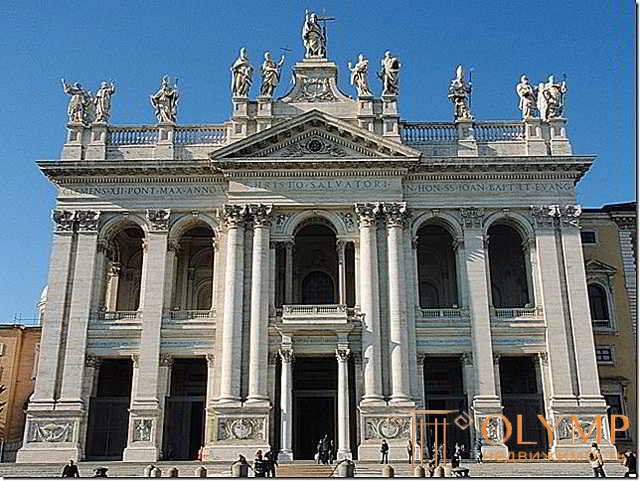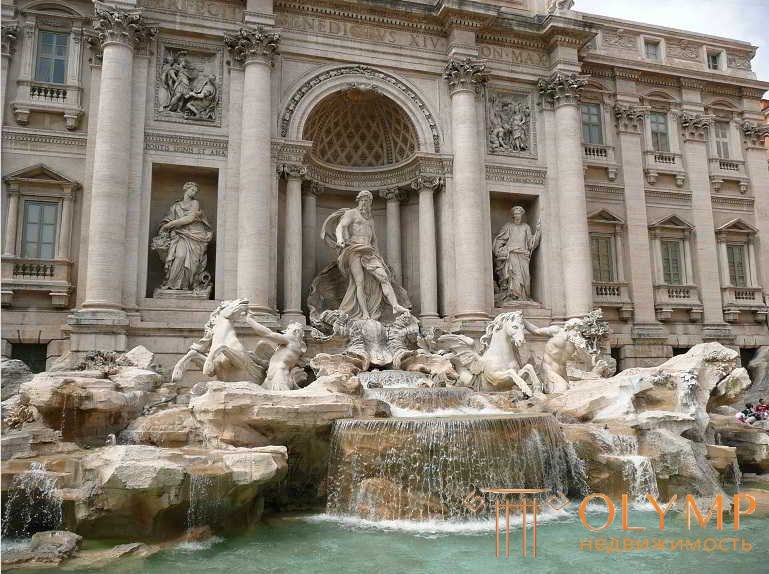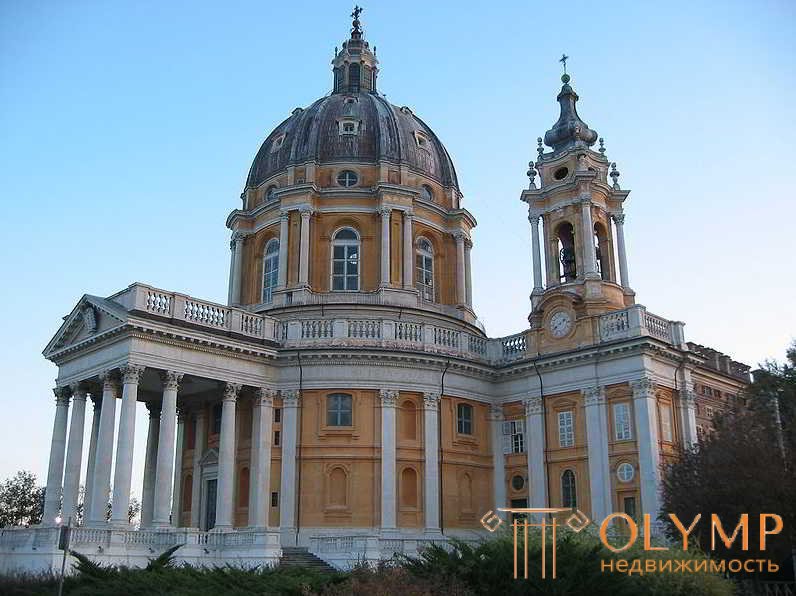
1. Italian architecture of the XVIII century
In the 18th century in Italy, the Baroque was finally crowded out by classical motifs in architecture. In general, this area is experiencing significant French influence, sometimes resulting in borrowings of the Rococo style. Due to the specificity of the political structure of Italy, art develops here in different ways in different cities.
The whims of the light-winged Louis XVI style were outlined, at least in the form of possibilities, as the last steps in the development of Italian Baroque. To return to a high renaissance and to antiques, the overwhelming majority of samples were on Italian soil, and even Italian scientists and artists such as Gori, Maffei and Muratori, like Piranesi, Fea and Ennio Quirino Visconti took an active part in the scientific and critical preparation of this turn. Decisive undertakings and writings that transformed the artistic life of their time came forth except for Piranesi’s publications, mostly from northern researchers and thinkers; At the same time, decisive stylistic changes took place - with the possible exception of theatrical structures and their decorative decorations - not on Italian, but on French, English and German soil.
In the Italian architecture of the 18th century, the last scions of Baroque can only be in the most typical cases sharply separated from the new classicism, which rarely goes deeper than Palladio; As for the French Rococo art, its influence on Italian soil can only be indicated in individual architectural structures, for example, in the decoration of the Palazzo Serra hall in Genoa, although performed by Frenchman Charles de Vaglia and representing the transition to Louis XVI style, as well as in magnificent halls of the Royal Palace and Philharmonic Society in Turin, owned by half Italian Baroque. In general, in the Italian architecture of the 18th century, from the very beginning almost completely avoiding the tortuous lines characteristic of Borromini or Gvarini, a slow process of rebirth takes place, leading gradually to a moderate, sometimes still pictorial, but mostly dry, classicism. In large church and secular architectural tasks and in the XVIII century there was almost no lack of Italian cities.

Fig. 212. The Church of San Giovanni Lateran Cathedral in Rome, built by Alessandro Galilee.
Already in Rome we are met by a whole range of magnificent church and palace facades, wide staircases and fountains of the 18th century. Festively elegant, created as if from a single piece of travertine stone in 1734 by the Florentine Alessandro Galilee (1691–1737), the facade of the Lateran Cathedral, whose two tiers of galleries, connected with semicircular arches, are connected by one row of Corinthian columns and pilasters, hardly deserves the name of Baroque . Since the Galilee lived for some time in England, Gurlitt even allows for the influence of the Rena school in this façade. His straight lines of Galilee preserved in the facade of the church of San Giovanni de Fiorentini, with two rows of correct Corinthian columns and pilasters. But the most successful Roman construction of this master should be recognized as the Corsica Chapel in the Lateran: a Greek cross in plan, with a noble dome over the center of the cross and box vaults in elegant cassettes, in all its details, is a pure echo of the golden 16th century. Again closer to the Baroque - the facade of the church of Santa Maria Maggiore, built in 1743 by Florentine Ferdinando Fugue (1699–1744), with powerful arched spans of the upper floor, as well as the palazzo della Consulate (1747) by the same architect, whose yard has only false promises arcades, and the Palazzo Corsica in Rome, famous for the beautiful real arcades of its courtyard and magnificent staircase. In the Baroque style, with a touch of classicism, the extensive Villa of Albani, the creation of Carlo Marchionne, and, despite the late appearance (1780), erected by Cosimo Morelli (died 1812), the triangular palace of Braschi, the private palace of the pope Pius VI, with a luxurious staircase. The Church of Santa Maria del Priorato (Priorato di Malta) on the Aventine Hill, built by Giovanni Battista Piranesi (1720–1778), publisher of Roman ruins and sketches of fireplaces, in which Schaefer sees the basics from the Empire style, is another example of “amazingly two-sided” as Burkgardt expresses himself in his “Chicheron”, a structure that stands on the border between baroque and classicism.

Fig. 213. Trevi Fountain in Rome, the work of Nicolo Salvi.

Fig. 214. Hall in the form of a Greek cross in the Vatican, built by Mikel Angelo Simonetti.
Only Michel Angelo Simonetti introduced this imitative antiqual style in the eternal city. The halls of the Vatican Museum, erected by Pope Pius VI, namely the Round Hall (ala Rotunda) and the hall in the shape of a Greek cross (Sala a croce greca), show a true twist in style.

Fig. 215. Superga Church in Turin, built by Filippo Yuvara.
In Turin, Yuvara performed in 1713 in the spirit of the moderate baroque Palazzo Madama, somewhat later the charming oval churches of Santa Cristina and Santa Croce, as well as the secularly graceful church of Santa Maria del Carmine, in the vicinity of Turin - Stupinigi Castle, famous for its amazing, probably French-owned Boffran, a plan and its magnificent architecture in the style of Italian Baroque, and, finally, standing on a high mountain, the magnificent Church of the Superga (1717-1731). To the church, inside an octagonal, outside circular central shape, known for a magnificent dome, he attached a prominent Roman Corinthian porch, topped with a classic pediment, in front; the building as a whole is a rather cold mixture of the motifs of the Roman high renaissance, the experience of baroque and appendages in the ancient spirit. To the buildings of Juvara in Madrid, where he died, we will return.
In Naples, a student from Juvara, Luigi Vanvitelli (1700–1773), the son of a promising Dutch painter Caspar van Wietel, represents the transition from baroque to classicism. His church of Santa Annunziata (beginning in 1760), a magnificent marble column building, the facade of which is below dismembered in the Ionic, and above in the Corinthian style, also has typical winding baroque lines. On the contrary, French motifs were used, especially in the garden, in his huge royal castle in Coserta. The center of the building is a talented octahedron, the classic pilasters enliven long wings and extensive courtyards.
Bologna also had capable architects; of these, Alfonso Torrezhani executed the huge facade of the church of San Pietro (1748), although in straight lines, but still restlessly, and in the palace facades, in the Palazzo Rusconi and the Palazzo Aldovrandini (1748–1753), in winding separate lines and the restless heap of motives he gave access to the most bizarre baroque ventures, while Carlo Francesco Dotti gave his San Luca church (1731–1739) located at the height of quite a rough, long-range oval, and rich and organic cutting that also distinguishes his palaces, nap Example in the Palazzo Agucca (1740), consisting of pilasters with square plates. Only Angelo Venturoli (1749–1820) is in his best Bologna buildings, for example, the staircase of Palazzo Ercolani with porticos around, a follower of classicism in the spirit of Palladio.
A student of Vanvitelli, Giuseppe Piermarini (1736–1808), already touched by the spirit of classicism, worked in Milan; , famous for its 300 granite columns. An even stricter and coldest follower of classicism is Simone Cantoni (1736–1818), who performed the noble white marble facade of the Doge’s Palace in Genoa, in 1794, the Serzelloni Busk Palace in Milan.
Vicenza was still under the influence of the classical late Renaissance of the great Palladio. Thus, Ottone Calderari (1730–1803) gave in his magnificent Palazzo Cordellin (1776), the Doric lower floor of which, decorated with rustic windows, carries an elegant Ionic upper floor, a work completely impregnated with the spirit of Palladio; in the same direction he worked in Verona Alessandro Pompeii, the customs (1758) and the Museum of inscriptions which expose the desire for classical purity of form.
Domenico Rossi (died in 1742) continued the traditions of Baroque and the direction of Longena in Venice. He owns the artsy facade of the church of St.. Eustachia and the magnificent Palazzo Corner della Regina. His nephew Tommaso Temantsa (1705-1789) embodied in such buildings as the round church, St.. Magdalene, classicism of the second half of the XVIII century, who found satisfaction in the cold imitation of the ancient orders of the columns.
What influence Italian architecture used in the 18th century shows its manifestations in neighboring countries. Italian architects even worked in France and in Spain and, as we shall see, prevailed in Russia and often in Germany. Italian art was not limited in its distribution only to the sea and the Alps.
Что бы оставить комментарий войдите
Комментарии (0)